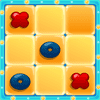Old King's Crown Board Game Review
Blog Andrew Joseph 06 Nov , 2025 0

Pablo Clark spent five years designing, perfecting and drawing his first board game, The Old King's Crown. During that time, rumors swirled among playtesters and convention crowds that the game was something special, with players taking on the role of asymmetrical factions competing to win domination of a fantasy kingdom. It's certainly better than we'd expect from a first-time designer. now since publication Crowdfunding Run, it's finally here and we can explore the Kingdom of Krak in all its glory.
what's in the box
To discuss “The Old King's Crown” we must first talk about art. It's right on the lid after all, and it's pretty cool. Rich in color, rich in detail, stylized yet recognizable, a world that has never existed is presented with dazzling precision. The fact that the designer is also an artist makes you wonder how he gets to the front of the line when talent is awarded.
Even when you slide off the gorgeous box lid, art is everywhere, adding story and context to nearly every image. It sits on a chessboard, a window in a tower overlooking the provinces of a civil war kingdom, as if the players are plotting in their own fortress while the people suffer. It sits on each faction's tarot-sized deck, filling in the broad narrative gaps in the rulebook's brief overview of the setting. It is found on all Kingdom cards as a faction-neutral buff for players to pick up. It's all surprising: every time you play, you'll notice something new.
All the graphic design and component quality here are gorgeous and engaging. The layout of the rulebook with its legends, the way the board carefully guides you through the various stages of each turn, the pleasing colors and layout of each faction marker and central board, embossed with pockets for cards and thick printed wood pieces in matching colours. The few remaining generic items: turn markers, conflict order markers, and a few other bits and pieces are simply black and gold wood.
Assembled as a whole, it takes up a large chunk of the table – but it looks incredible, with the wood and cardboard inviting one to stop and stare, a whole world laid out in squares and circles for those who take the time to look and appreciate.
Rules and gameplay
It's a fairly complex game, but the complexity lies in the sheer density of information available rather than the relatively simple core gameplay flow. The game lasts for a fixed number of rounds, usually five, with each round divided into four seasons. The main content of the game takes place during the summer, and players will fight in three locations, each with two possible rewards, chosen by the winner. First, players place their pioneers in order at one of the victory points, and if they win there, they receive bonus points. They can then place a small group of supporters in a location, which provides a small combat bonus. Next it’s time to play cards.
All players start with a functionally identical deck from which they draw six cards. Each person places a card next to each location, face down. They then work one problem at a time, each turning over a card and adding the number on that card to the number of supporters there. The one with the highest total score wins. But many times, this is not the case.
The reason is that many cards have action icons, and calling those icons complicates things. For example, Ambush allows the owner to play a second card during melee. Flanking lets the card slide out of the current battle and into future battles. There are others, but the scariest is Fatal, which happens after all other actions and kills the enemy card, removing them from the game and going into the dreaded “lost pile” for the rest of the game, unless they have a helmet or shield icon, the latter of which also keeps them in combat at that location.
It's hard to overstate how intense it was. When someone flips a card, everyone cranes their necks across the giant board, eager to decode the game's intricate symbology to find out who's in contention and what the next move might be. Battles decided by ambushes, or value ties resolved through additional card games, are even more exciting, as are deadly attacks that permanently assign key cards to the missing deck. When it comes to Pioneers, the stakes are through the roof.
All locations' scores are affected by yours, which is the name of the victory score in the game. But if you win on the space where you placed the Herald, you get extra points. If you win on a space where you and others have placed their Heralds, you gain a victory point for each poor unfortunate. This is a game where winning scores can range up to 15-20 points, so actually taking points from other people to add to your own score is huge. Carefully calculated pioneer positions can take you from last to first in one fell swoop, ensuring everyone is in contention until the end.
This will naturally lead to all kinds of conspiracies. The scrap pile is public information, so you can dig through people's trash to see if they've played that deadly card, or if it's still lurking in their hands to mess with you. Players can also purchase additional cards to add to their decks, which not only come from asymmetric decks tailored to your faction, but can also add more wrinkles to the formula, such as changing it to the lowest card win rate. If you want to minimize the chance of an accident happening, you need to pay extremely keen attention to what other people are doing.
Purchasing new cards is just one way of embodying the asymmetry of the game. Each faction has a set of four special one-time powers, plus a fifth that you can call upon if you win a specific position. They're all unique and generally fit the faction's thematic playstyle. A party representing a cult-like Ecclesiarchy can swap the positions of two cards during combat, or sacrifice cards to the lost deck to gain resources to purchase more cards. In contrast, an uprising is a revolution among the ordinary people of the country, which can bring fatal effects to the cards, or a retreat effect.
When you start weaving together a variety of unique card effects, asymmetries, special abilities, and positional victory effects, you can start to see all the ways you can affect not just individual conflicts, but the entire game state. As the game goes on, your hand size will decrease unless you can arrange something so that this doesn't happen. You will lose supporters unless you find a way to win them back. If you buy enough new cards, you'll be rewarded with points, but you'll have to make huge sacrifices to do that. The number of ways you can get close to the old king's crown and still win is absolutely jaw-dropping and almost heartbreaking in the loop within the loop.
There's more! So far, we've only really talked about what's going to happen in the summer. During the Spring, players can use their cards to bid on a series of Kingdom cards, most of which are inherently destructive. They allow you to exchange a drawn card for one from the missing deck, steal another player's special ability, or give your cards additional effects. Each is enough to easily build a strategy around on its own, but you can keep up to two of them. Except after the initial bid, you can steal kingdom cards from other players instead of taking a new card, forcing them and you to re-plan on the fly.
In the fall, you can send cards to Journey, which gives you the opportunity to buy more cards, or you can send them to Council, where they stay and provide long-term special abilities. If you win with your Herald, this could mean potentially more points, a chance to regain a supporter, or other effects. In the end, winter is just a bookkeeping phase and, frankly, a chance to catch your breath after an absolute break. strategy And a whole round of social madness in The Old King's Crown.
This is no exaggeration. While there's a surprising amount of fun to be had here, the sheer number of details you need to consider in order to maximize your chances is almost overwhelming. You need to be on top of your own special abilities and special cards, as well as other people's special abilities and special cards, what they're buying, what they're playing, what's in their discard pile or loss pile. You need to know each player's kingdom cards, their actions, and the bids you need to make to steal them or protect your own kingdom cards. Initially this seemed impossible. With practice, it gets easier, but you'll need to play this game an incredible amount if you want to internalize it properly.
However, you don't need to do all of this to win. Even though the sheer amount of detail can mess with your thought process, it's totally okay to play more from the hip. And you can get away with it, because essentially you can check every discard pile in the game and still not be sure if the player just threw their fatal card into the vanguard position, or if it was a tricky bluff. You can do well just by reading faces, voices, and body language. This creates a strange tension at the heart of The Old King's Crown: a game that gives you the most amazing range and leverage to strategize, and then lets other players pull the rug out from under you through cunning bluffing.























